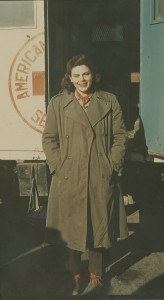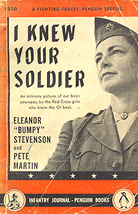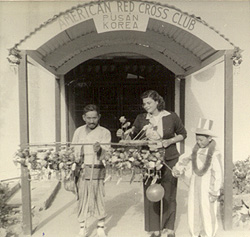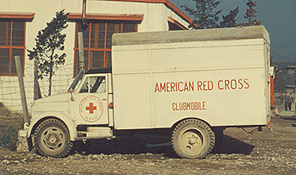Photos and Letters of Helen Stevenson Meyner in Japan and Korea, 1950-1952

While vacationing in Scotland in early October 1950, Helen Day Stevenson received a telegram from her father, William Edwards Stevenson, which read, “Interesting opportunity immediate Red Cross Club Service Korea.” In a letter expanding on the telegram, Bill pointed out that he and his wife, Eleanor, believed that this was a unique and important opportunity for their daughter. Though she “would see a lot of the world, meet all sorts of people, including assorted wolves,” it would prove to be a positive experience and, he said, “We will speed you on your way if it appeals to you.”
Helen’s parents knew first hand about serving in the Red Cross during war time. In the spring of 1942, Bill left the United States to take charge of Red Cross operations in Great Britain. Leaving a lucrative law practice in order to assist with the war effort, Bill served as American Red Cross delegate to Great Britain until November 1942, at which time he became ARC delegate to North Africa. His main responsibility was the establishment and administration of relief for the troops of the American Fifth Army as they advanced from North Africa, through Sicily and into Italy.
Eleanor, better known as “Bumpy,” joined her husband as a Red Cross worker in Great  Britain and was also transferred to Africa, serving as a recreational worker in Algiers. Following the Allied invasion of Italy, Bumpy served for eight months between 1943 and 1944 with a Clubmobile unit, working – often under fire – at Salerno and Anzio. Bumpy published her impressions and experiences with the American Red Cross in her book, I Knew Your Soldier. Through their own work in the Red Cross, Bill and Bumpy instilled a sense of responsibility and understanding in their daughter which helped make her a valuable and effective ARC recreational worker. By early November 1950, following a week of training in Washington, D.C., Helen was aboard a Royal Canadian Air Force plane en route to Japan with three officers, some thirty enlisted men, and several other women. All were headed to the Far East to contribute to the war effort in Korea. The women were all recreational workers with the American Red Cross.
Britain and was also transferred to Africa, serving as a recreational worker in Algiers. Following the Allied invasion of Italy, Bumpy served for eight months between 1943 and 1944 with a Clubmobile unit, working – often under fire – at Salerno and Anzio. Bumpy published her impressions and experiences with the American Red Cross in her book, I Knew Your Soldier. Through their own work in the Red Cross, Bill and Bumpy instilled a sense of responsibility and understanding in their daughter which helped make her a valuable and effective ARC recreational worker. By early November 1950, following a week of training in Washington, D.C., Helen was aboard a Royal Canadian Air Force plane en route to Japan with three officers, some thirty enlisted men, and several other women. All were headed to the Far East to contribute to the war effort in Korea. The women were all recreational workers with the American Red Cross.
Helen arrived in Japan on November 3, 1950. A small group of women were setting up the first Red Cross club located in the city of Pusan, South Korea. Due to the fluid lines of battle in the first winter of the Korean conflict, the Red Cross was not permitted to establish any more clubs until the spring of 1951. In the meantime, Helen was sent to the Fifth Station military hospital at Johnson Air Base in Irumangawa, Japan. Daily, wounded soldiers were flown to Johnson for a period of recuperation before either being sent home to the states or back to the front. It was during the soldiers’ stays at the hospital that they came into contact with the Red Cross women, who spent between twelve and fourteen hours a day comforting and entertaining sick and injured soldiers.
Despite the importance of her work in Japan, Helen was eager to get to Korea. She was so eager, in fact, she tells her family that on the fifth of April, when she received her orders to go to Korea, “I was so thrilled and excited, I nearly hit the roof.”
On April 13, 1951, Helen arri ved at the ARC club in Pusan, on the wall of which the Red Cross women hung a sign describing the purpose of their presence in Korea:
ved at the ARC club in Pusan, on the wall of which the Red Cross women hung a sign describing the purpose of their presence in Korea:
“With the hope that this little piece of America transplanted in Pusan may be a source of comfort and happiness, this Club is affectionately dedicated to the men of the U.S. Armed Services and to their friends in the United Nations Forces.
Comfort and happiness” was provided in the form of platonic companionship, coffee, and doughnuts. “As many as 8,000 in one day,” either heading to or returning from the front, “invaded the Club” at Pusan and were greeted by only a handful of Red Cross women. The women answered questions, listened, shared a smoke, and played games with the men, who if only briefly, were permitted simultaneously to forget where they were and remember what they were fighting for.
While Helen did work in the club, she was primarily assigned to the clubmobile while in Pusan. A converted Russian truck, the clubmobile carried Helen and a co-worker to isolated units in the areas surrounding Pusan. From this truck, coffee and doughnuts were dispensed, always along with “a witty line of chatter.” Helen remained at the club in Pusan until October 1951, at which point she was transferred to a club at K13 Suwon Air Base. She continued her work along the same lines until she left Korea for home in January 1952.
This exhibit is a chronicle of Helen’s time in Japan and Korea, using photographs and text from her personal papers to tell the story of one woman’s experiences living in the war theater.
All quotes and images in this exhibit are from the Robert B. and Helen Stevenson Meyner Papers, Skillman Library, Lafayette College.
This exhibit contains only a small sample of the riches contained in this collection dealing specifically with Helen and her family’s work with the American Red Cross. Helen’s impressions and experiences as related in her diaries and letters home are vivid, entertaining, and often moving and insightful. She comments on her work, her social life, her surroundings, the war situation, issues of race and, of course, the soldiers. And while at first glance, Helen’s letters may appear a mere recounting of her daily tasks in both Japan and Korea, they contain a startling glimpse into the hearts and souls of both the soldiers sent to fight on foreign soil and the women who risked their lives to make that fight easier.
The Robert B. and Helen Stevenson Meyner Papers contain Helen’s correspondence to her family during this period, as well as scrapbooks and photographs. Of additional interest may be Helen’s diaries and correspondence with her parents written between 1942 and 1944, the time during which her parents served in Europe and Africa with the Red Cross.
Those wanting to learn more about Helen and her work in Korea & Japan, as well as her family’s history of service with the American Red Cross, are encouraged to explore more deeply the Robert B. and Helen Stevenson Meyner Papers, which are available for research in the Special Collections & College Archives of Skillman Library, Lafayette College.
Exhibit created by Kathy Stewart, 1991. WordPress design by Alena Principato ’15.
